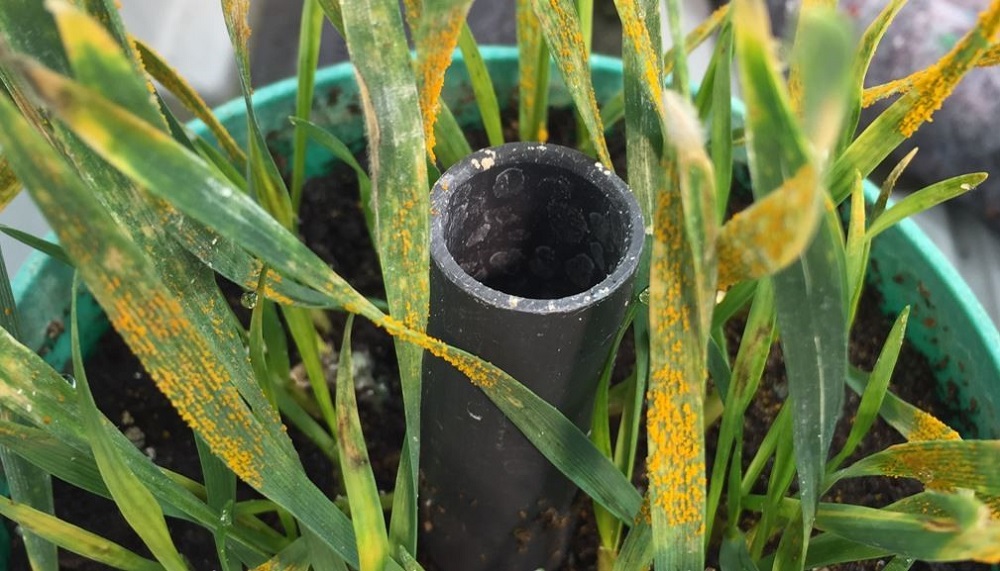‘Interesting’ wheat yellow rust isolates identified by UKCPVS
Friday, 19 March 2021
The UK Cereal Pathogen Virulence Survey (UKCPVS) continues to detect new and interesting wheat yellow rust isolates associated with unique crop disease patterns. AHDB crop scientist Robert Saville reports on the latest developments and what it means for management.
It is no longer news that the pathogen behind yellow rust – Puccinia striiformis – is dynamic and diverse. Its nimble nature means it has acquired the genetic security codes needed to better access a lengthening list of winter wheat varieties.
As we gear up for the main spray timings, eyes will be on wheat for signs of active yellow rust, accompanied by an almost paranoid (but, potentially, justified) level of questioning – is this variety showing disease levels above what the AHDB Recommended Lists (RL) disease rating suggests?
Keeping up with the pathogen isn’t easy. However, recent changes to disease rating calculations mean the RL is now in a far better position to reflect recent alterations in the yellow rust population. Earlier this year, we also issued a yellow rust ‘watch list’ to flag varieties that performed out of line with their RL disease resistance rating at some trial sites.
The new developments in the RL give confidence and will help focus monitoring efforts this season. However, when it comes to the coordinated and strategic monitoring of cereal pathogens, the AHDB/APHA-funded UKCPVS excels. It has monitored changes to key cereal pathogens for many years. In fact, it is over 50 years since it published its first findings (1967). Last week, the team held the 2021 stakeholder meeting (online).
The service relies on you – the farmers, agronomists, scientists and breeders – to send in infected leaf material. The NIAB-led UKCPVS team then focuses on the most unusual infections – with disease ‘isolates’ from highly resistant varieties (according to their ratings) first in line for the controlled differential/varietal tests.
Wheat yellow rust results
The UK yellow rust population has seen significant race changes over the last 10 years – and it is easy to fear the worst, especially when a lot of disease is seen in crops. ADAS’ Jonathan Blake spoke at the event and looked at the potential reasons for the relatively widespread yellow rust in wheat crops during 2020. Obviously, the diverse yellow rust population plays a part. However, two other reasons were probably behind the elevated disease levels.
Firstly, there was a lack of inoculum-curbing frosts over the 2019/20 winter. Secondly, the drilling conditions in autumn 2019 meant many crops went in later. Although counterintuitive, later-sown wheat tends to be associated with more yellow rust. This may be due to such crops being younger during the early part of the ‘disease season’.
The relatively high rust levels in the field resulted in a large amount of infected leaf material sent to the UKCPVS in 2020 – 306 samples of wheat yellow rust were received (with most received in June). Pathogen isolates from these samples were used to challenge a set of wheat varieties that contain known yellow rust (Yr) resistance genes to build up a profile of the pathogen population (differential tests).
This found that the virulence (ability to cause disease) frequencies associated with the main yellow rust resistance genes in 2020 continued to follow the patterns of previous years, with virulence frequencies high for many of these genes. However, in 2019, the UKCPVS saw a significant increase in the incidence of Yr8 virulence. Interestingly, the percentage of isolates carrying virulence to Yr8 has now returned to levels previously observed before the spike.
.png) AHDB
AHDB
These days, it’s not unusual to discover new yellow rust pathotypes in the UK. Five were identified during 2020, with one isolate exhibiting virulence for Yr8. However, further analysis is needed to unpick the precise cause and effect, and to establish the risk to UK varieties.
Adult plant trials in 2020 (conducted on RL varieties and candidates) also provided further evidence of the resistance-picking diversity of the UK yellow rust population. In fact, some varieties only reacted to one of the five isolates tested. Such results reveal why regional variation is commonly observed for this disease.
As with the trend over the last ten years, the majority of isolates identified were classified as members of the diverse ‘red’ genetic group, with the most common pathotypes belonging to Red 37 and Red 28 (the number is based on their ability to cause disease in variety tests).
Further information
Jonathan Blake’s presentation focused heavily on control in the field. It covered a lot of ground. However, a standout point was on how to deal with fast-moving rusts, compared with slower-infecting septoria. Using the AHDB Wheat disease management guide, he explained how the published control curves are based on septoria data (black solid lines in graph, below). However, the faster-cycling rusts, with their shorter latent period, result in tighter curves (yellow dotted lines in graph, below). He said this potentially could result in a gap in yellow rust control between T1 and T2 – especially when conditions are conducive and the variety is particularly susceptible.
.png) AHDB
AHDB
Mogens Hovmøller (Aarhus University) also provided a fascinating insight into the RustWatch project, which coordinates monitoring of wheat rusts across Europe, including the activity of the UKCPVS.
Because of the highly dynamic nature of rust populations, all varieties should be monitored closely and unexpected disease levels reported to the UKCPVS.
The AHDB website contains full results (e.g. brown rust and powdery mildew), including presentations, young-plant-stage resistance data and sampling information: ahdb.org.uk/ukcpvs
UKCPVS video and presentations
The UKCPVS 2021 papers and video are available from the event page
Wheat yellow rust: disease ratings, monitoring and control (2021 blog)



